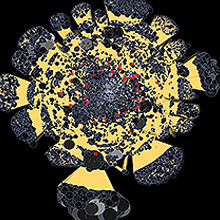Health Informatics
Computer Science affects a wide range of disciplines. In the Department of Computer Science, a number of our researchers pioneer projects that have a health-related focus. The following is a glimpse at the exciting research work in the Department.
IEPI: A Smartphone-Based Epidemiological System

If you're sick, should you stay home from work? And if you do, what effect will it have on the spread of disease in your workplace, or in your city?
These are the type of questions that the iEpi project seeks to answer.
iEpi is data-collection software developed by Professors Nate Osgood and Kevin Stanley and their research teams. The software is meant to run on smartphones, which volunteers carry with them during their day-to-day routine. Not only does the software track a volunteer's daily movements using GPS, but it can also detect, via wireless sensing, whenever two smartphones running iEpi come into close proximity. The software can also routinely query study participants with very short, context-sensitive questions about their daily activities.
The data collected by iEpi can be used by researchers to build powerful computer models for predicting the spread of the flu and other infectious diseases. Research findings from these models are useful not just for individuals wanting to make good decisions about their own health, but also for health administrators and researchers looking for ways to improve public health as a whole.
Usask Article
Canines Show Promise as a Cancer Research Model

Dr. Tony Kusalik, from the Department of Computer Science, is the team's expert in bioinformatics. Cancer-treatment drugs work by targeting individual genes in the patient's genetic make-up. Since dogs - and humans - have many thousands of genes encoded in their DNA, computer-assisted analysis is essential for understanding which genes are being affected by the drugs. Not only that, but Dr. Kusalik plans to employ machine-learning techniques to build models that can predict in advance when a patient is going to develop a drug resistance.
Because dogs age much faster than humans, the researchers anticipate having useful results within as little as two years, and could be ready to begin a similar project with human cancer patients.
Usask Article
Parametric Human Project (PHP)

The Parametric Human Project (PHP) is an established Canadian-led international consortium of researchers, scientists and software developers that aims to accelerate research in domains that include computational anatomy, medicine, biomechanics, ergonomics and entertainment. PHP enables researchers to easily access and contribute to a growing collection of digital human models. The project aims to create a common set of software tools that enable researchers to unify and process data, create models from individual and aggregate data, and simulate human motion and function. Dr. Stavness is specifically focusing on models of the tongue, lips, and vocal tract for simulations of speech production, models of the jaw and teeth contact for dentistry, and models of the shoulder and chest for analyzing shoulder dysfunction common in Breast cancer survivors.
Large-scale digital human modeling has the potential to revolutionize biomedical research and associated disciplines. For example, statistical models are based on data from hundreds to thousands of subjects, and can be used to create subject-specific models from noisy or incomplete medical data, or to design medical devices to benefit patient populations. Dynamic modeling and simulation of human motion can generate predictions about functional outcomes from surgical and rehabilitation treatment plans to inform clinical decision-making.

